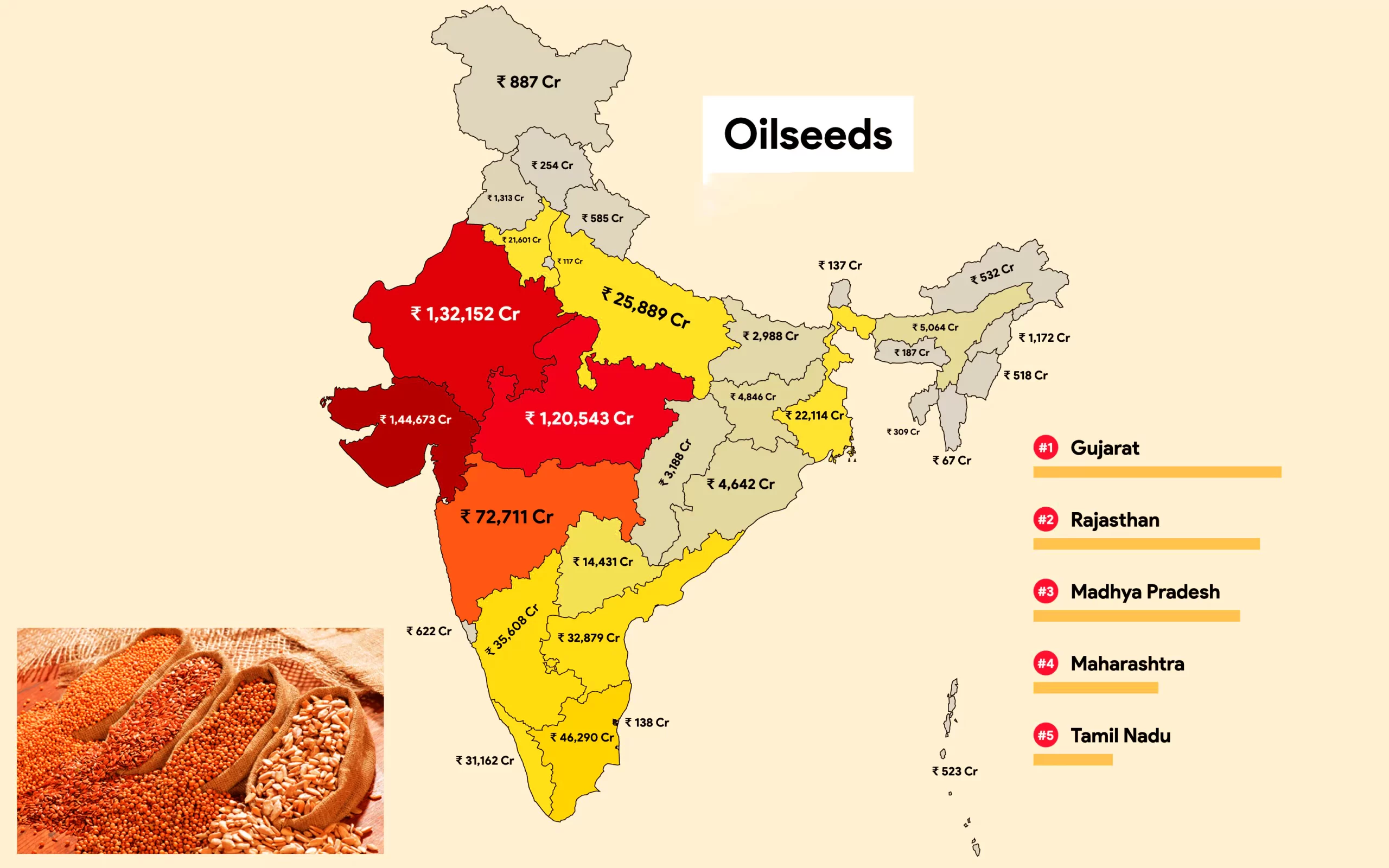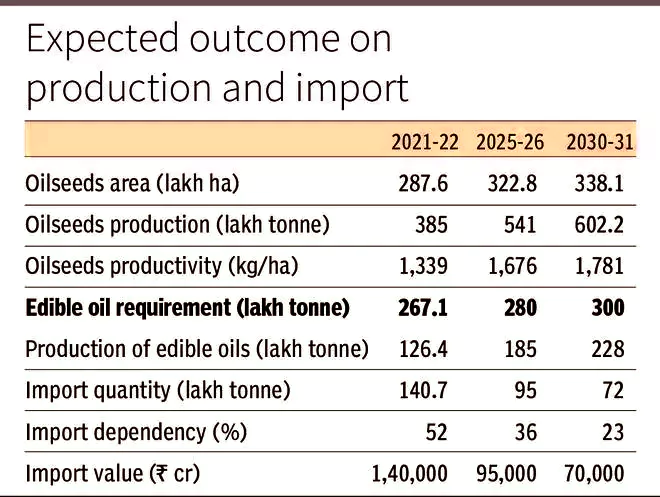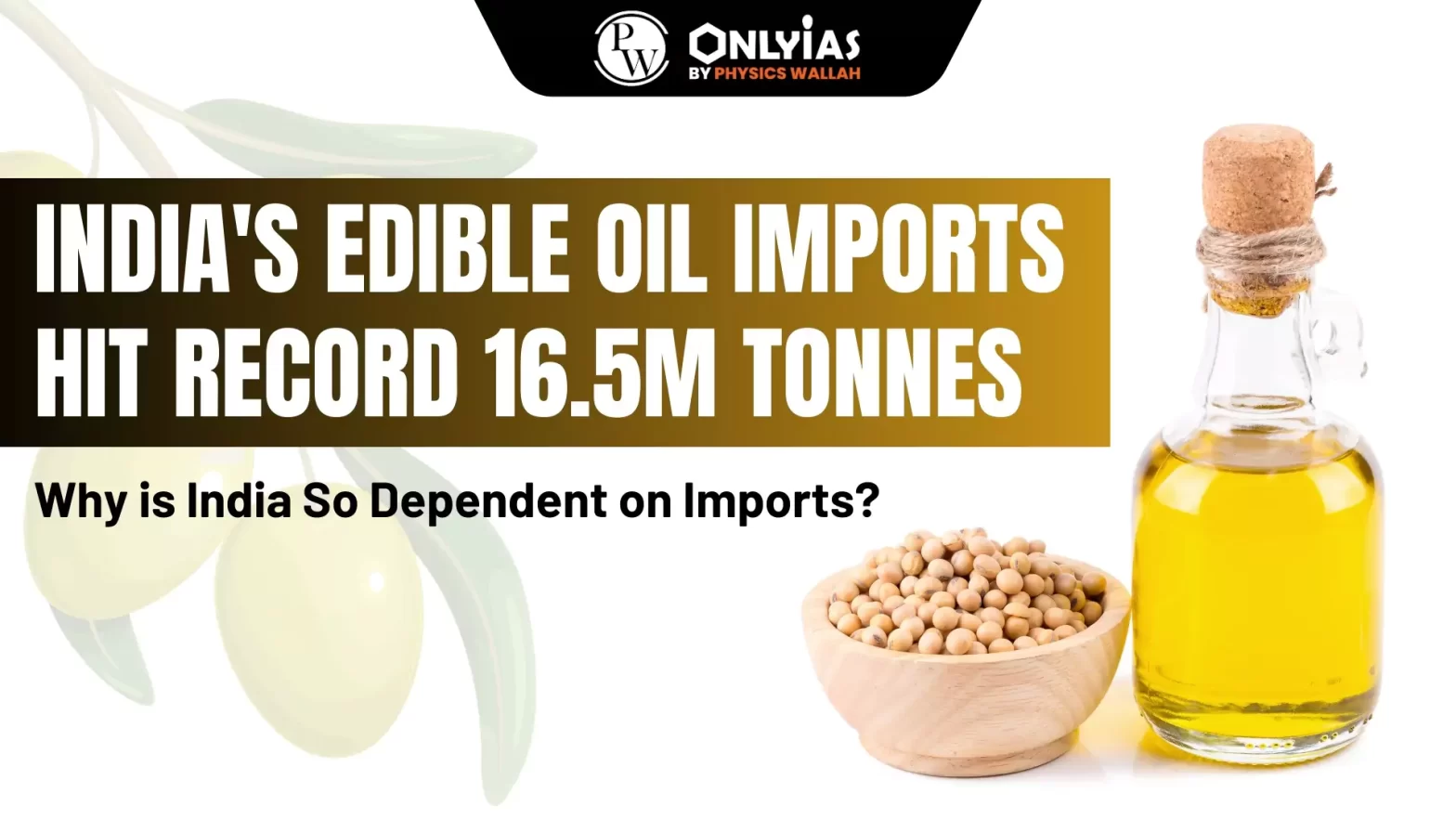Context:
- This article is based on the news “The other oil imports India needs to worry about” Which was published in the Live Mint. India’s edible oil imports have risen almost 1.5 times and more than doubled in rupee value terms during the last 10 years.
India’s Edible Oil Imports Hit Record 16.5M Tonnes
- Edible oil imports — used in cooking and frying of foods, as opposed to petroleum fuels — touched a record 16.5 million tonnes (mt) in the year ended October 2023, according to data from the Solvent Extractors’ Association of India (SEA).
- From a 10-year perspective, India’s edible oil imports have increased from 11.6 mt (valued at Rs 60,750 crore) in 2013-14 to 16.5 mt (Rs 138,424 crore) in 2022-23, with the jump pronounced in the last three years.
What types of oilseeds are commonly used in India?
- Groundnut, mustard, rapeseed, sesame, safflower, linseed, niger seed, and castor are the major traditionally cultivated oilseeds.
- Among the non-conventional oils, rice bran oil, and cottonseed oil are the most important. In addition, oilseeds of tree and forest origin, which grow mostly in tribal inhabited areas, are also a significant source of oils.
- India’s several regions have developed specific preferences for certain oils largely depending upon the oils available in the region.
-
- For example, people in the South and West prefer groundnut oil while those in the East and North use mustard rapeseed oil.
- In India, the majority of the oilseeds are cultivated under a rainfed ecosystem (70%). Only 28% of the oilseeds area is covered under irrigation.

| Oilseeds Cultivation in India:
Ground Nut:
- It thrives best in the tropical climate and requires 20°-30°C temperature and 50-75 cm rainfall.
- It is highly susceptible to frost, prolonged drought, continuous rain, and stagnant water.
- Dry winter is needed at the time of ripening.
Linseed:
- Although this crop can be grown under varied geographical conditions, it prefers a cool, moist climate with about 20°C temperature and 75 cm rainfall.
- Clay loams, deep black soils, and alluvial soils are best suited for its cultivation.
- It is a rabi-crop which is sown in Oct-Nov. and harvested in March-April.
|
What is the consumption pattern of edible oils in India?
- During the 1980s and 1990s, per capita consumption of edible oils was at 6-7 kg per person per year. India was more or less self-sufficient to cater to that need.
- The per capita consumption which was 7.3 kg/year in 1994-95 increased to 18.3 kg/year in 2014-15.
- The Indian Council for Medical Research (ICMR) recommends 30g per person per day of edible oils — that is 12 kg per person per year.
What is the current status of oilseeds in India?
- India accounts for about 15-20 percent of global oilseeds area, 6-7 percent of vegetable oils production, and 9-10 percent of the total edible oils consumption.
- In terms of acreage, production, and economic value, oilseeds are second only to food grains.
- As per the fourth advance estimates for 2018-19, the area and production of nine oilseeds crops is 25.5 million hectares (Mha) and 32.26 million tonnes (MT), respectively.

What challenges does the edible oil sector face in India?
- Reliance on Imports: India heavily depends on imported edible oils to bridge the supply-demand gap which is often interlinked with uncertainties such as fluctuating global prices due to geopolitical conflicts(Russia-Ukraine war)
- Despite the government’s effort to decrease the edible oil dependency on the world, India will still have to import 72 lakh tonnes of edible oil at the value of ₹70,000 crore in 2030-31, which would be 23 per cent of the total requirement of 300 lakh tonnes edible oils
Why is India so dependent on imports?
- Home-grown soybeans, mustard, and groundnut oil, among others, meet just 40% of requirements.
- Oilseeds productivity of a tonne per hectare is less than half the global average, due to lack of access to the latest seed technology.
- Farmers also hesitate to grow oilseeds as they cannot compete with the flood of cheap imports and lack of price support mechanisms.
|
- Productivity and Yield: Low productivity and yield levels in oilseed cultivation pose a significant challenge.
- Inadequate infrastructure, lack of high-quality seeds, limited mechanization, and poor farming practices contribute to lower yields, reducing the competitiveness of domestic production.
- For Example: If we just bring Mustard acres in India to global yield levels of 1980 kg/ha, we can reduce edible oil imports by a good 15% (within the same area) and hybrid seeds will play a key role in reversing the balance of trade.
- Land Constraints: Limited availability of arable land and competition with other cash crops present obstacles to increasing oilseed cultivation.
- The expansion of oilseed acreage requires strategic planning, research and development, and farmer education to optimize production.
- Storage and Distribution: Inadequate storage facilities and supply chain inefficiencies result in post-harvest losses and higher prices for consumers.
- Lack of a defined procurement policy: Efforts are needed to implement the Minimum Support Price (MSP) along with a bonus for enhancing the net income of the oilseed farmers.
- In spite of a regular enhancement in MSP of oilseeds crops, the lack of a defined procurement policy does not encourage the farmers to take up the cultivation of these crops
- Dependency on climatic conditions: Most of the oilseeds are cultivated on marginal land and are dependent on rainfall and other climatic conditions.
- Even before the war, global vegetable oil supplies had tightened due to a drought in South America which resulted in the reduction of soybean yield.
- Malaysia’s palm production, too, declined due to the impacts of Typhoon Rai in December 2021.
- Drought-impacted Canadian rapeseed production for 2021-22 declined 35 per cent from the previous year.
Government’s Efforts:
- National Mission on Edible Oils (Oil Palm): Launched in 2021-22, it aims to increase the cultivation area from 0.35 Mn h.a. to 1 Mn h.a. by FY26.
- Centrally Sponsored
- Special Focus: North East region and Andaman & Nicobar Islands
- Indian Oilseeds and Produce Export Promotion Council (IOPEPC): IOPEPC was formed in 1956. Its primary aim is to promote and protect India’s export trade in commodities like oilseeds, vegetable oil, and oilcake.
- Directorate of Oilseeds Development (DOD): DOD was formed in the year 1942 and is responsible for supervising the Oilseeds Development Programmes and Oil Palm Development Programmes across the country and in the designated states of Andhra Pradesh, Kerala, Tamil Nadu, and Karnataka.
- Setting up of Oil Palm Mills: The government has also aimed to set up new Oil Palm Mills with a special focus on Arunachal Pradesh and Andaman and Nicobar Islands.
|
Way Forward:
- Technology application and adoption: Development of new hybrids and varieties using the double haploid approach, marker-assisted breeding/selection, and other biotechnological approaches to solve viability (sunflower and soybean) and seed production issues should receive top priority amongst researchers to enhance oil production.
- For Example: The productivity (yield) gap between improved technology and farmers’ practices ranged from 21 per cent in sesame to 149 per cent in sunflower.
- Storage and Infrastructure Development: Strengthening storage infrastructure and improving logistics and distribution networks are crucial to minimize wastage and ensure a steady supply of edible oils.
- Diversification of Oilseed Cultivation: Encouraging the cultivation of alternative oilseeds, such as palm, canola, and olive, alongside traditional crops can help reduce import dependency and increase domestic production.
- Effective implementation of MSP: The mechanism of minimum support price (MSP) though available is not in operation in major oilseeds producing states. Therefore ensuring the market intervention for effective implementation of MSP through procurement of oilseeds in case of fall in open market prices is needed.
- Tapping the Private Sector: The potential of public-private partnership (PPP) through linkages in all aspects of production, processing, and marketing needs to be harnessed.
- The PPP model can be useful in several aspects of the oil economy such as seed production, forward-backward linkages for processing, value addition, contract research in niche areas, contract farming and joint ventures for higher-order derivatives and specialty products, and so on.
- Free Trade Agreement (FTA) partnerships: India must now also prioritize the development of a resilient supply chain, leveraging its Free Trade Agreement (FTA) partnerships within the Association of Southeast Asian Nations (ASEAN), specifically with Indonesia, Malaysia, and Thailand, as these countries are major exporters of palm oil.
- By tapping into these established trade ties, India can address its edible oil needs.

Conclusion:
India’s increasing reliance on edible oil imports calls for urgent measures such as improving productivity, and infrastructure, diversifying cultivation, and forming strategic partnerships to enhance food security and reduce dependence on global markets.
| Prelims Question (2018)
Consider the following statements:
1. The quantity of imported edible oils is more than the domestic production of edible oils in the last five years.
2. The Government does not impose any customs duty on all imported edible oils as a special case.
Which of the statements given above is/are correct?
(a) 1 only
(b) 2 only
(c) Both 1 and 2
(d) Neither 1 nor 2
Ans: (a) |




